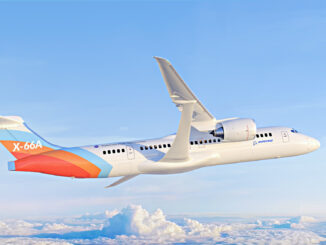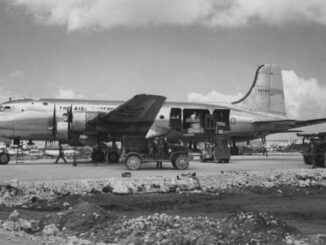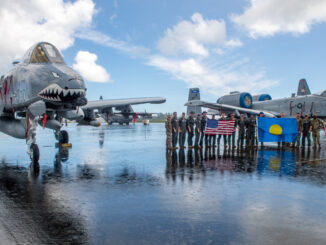 The United States Air Force Air Demonstration Squadron ´Thunderbirds´ has just opened its anniversary season with a winter training trip to New Mexico. Between 9th and 20th January, the team´s pilots practiced their show at Spaceport America to be ready for the 2023 season – the season that marks the 70th anniversary of that official jet aerobatic team of the USAF.
The United States Air Force Air Demonstration Squadron ´Thunderbirds´ has just opened its anniversary season with a winter training trip to New Mexico. Between 9th and 20th January, the team´s pilots practiced their show at Spaceport America to be ready for the 2023 season – the season that marks the 70th anniversary of that official jet aerobatic team of the USAF.
The Thunderbirds team was officially established on 25th May 1953, as the 4520th Air Demonstration Squadron of the 3600th Fighter Training Wing. At the beginning, the team was based at Luke Air Force Base, Arizona and flew with Republic F-84G Thunderjet aircraft. Major Richard C. Catledge, a former combat pilot of the 1st Fighter Group, became the first Thunderbirds team leader and commander. During the World War II, Catledge flew a P-38 Lightning and completed twenty-three missions in the Mediterranean Theatre of Operations. He was shot down in August of 1943, captured by the enemy but escaped and experienced a long and dangerous nine-month-long way back to the Allied territory.
On their initial season, the Thunderbirds performed twenty-six aerobatic displays around the United States. An interesting fact is that six initial shows were flown as Stardusters and only then the name of the team was changed to Thunderbirds. The new designation came from the local Indian culture and meant the creature that ruled the sky.
Next year, the team flew its first overseas show while touring the South and Central America. In 1955, the Thunderbirds switched to Republic F-84F Thunderstreak . It remained the team´s display aircraft for the next ninety-one shows.
In June of 1956, the Thunderbirds gained supersonic capability, switching the display aircraft to North American F-100C Super Sabre. Also that year, the team moved to Nellis Air Force Base in Nevada where it was assigned its own facilities. The new aircraft meant a revision of the aerobatic programme flown by the Thunderbirds. A few new manoeuvres were added, and the show was enriched by a very special display – a supersonic boom performed by a solo F-100C. Regrettably, that part of the programme was shortly after banned by the Federal Aviation Administration (FAA).

Cancelling the supersonic display was just the first intervention of the FAA into the Thunderbirds programme. A few other occurred during the 1960s, in order to increase safety of air show spectators.
In 1963, the Thunderbirds successfully completed their first European tour. Next year, the team changed the aircraft again, this time for Republic F-105 Thunderchief. Regrettably, on 9th May 1963, one of the Thunderbirds´ pilots, Capt. Gene Devlin, was killed during a show flown at Hamilton Air Force Base. His F-105 exploded mid-air during climb that followed the final fly-by before landing. An investigation stated that the reason was structural failure of the aircraft. In effect, the Thunderbirds returned to fly with the Super Sabre and stayed with that aircraft until the end of the 1968 season.
The year 1967 was marked with the 1000th show flown by the Thunderbirds. Two years later, new aeroplane was introduced into the team – McDonnel Douglas F-4E Phantom.
Regrettably, the Thunderbirds´ pilots were able to enjoy flying with that great combat aircraft only for a short time. The early 1970s were marked by oil crisis that also affected the air force. Therefore, the team performed only six shows in 1973, and shortly after was forced to say goodbye to the Phantoms and switch to more economic aeroplane, Northrop T-38 Talon. That also meant a significant revision of the aerobatic programme flown by the Thunderbirds.
18th January 1982 was a black day for the Thunderbirds. During the pre-season training at Indian Springs, four T-38s of the team were flying the diamond formation and performing a line abreast loop manoeuvre while they nosed into the desert floor and burst into flames. All four pilots – Maj. Norm Lowry, Capt. Willie Mays, Capt. Joseph ´Pete´ Peterson and Capt. Mark E. Melancon – were killed on the spot.

The training and accident itself were filmed by the team´s ground crew and the footage was used for investigation purposes. The manoeuvre flown by the formation was expected to end at altitude of about 100 feet, with all aircraft safely levelled off from the sharp descent. Instead, the T-38s hit the ground at high speed of approximately 640 kph.
Among the first speculations there was a possible leading pilot´s mistake and misjudging both altitude and speed. Nevertheless, the final conclusion was that jammed stabilizer of the leading aircraft was the reason of the accident. The remaining three pilots merely followed their leader, as commonly practiced during the formation flights.
On 17th May 1982, a five-pages-long report from the accident, now commonly known as ´the Diamond Crash´, was openly published in Aviation Week and Space Technology magazine. All existing copies of the tapes recorded during the crash were officially erased and destroyed in order to prevent from possible media leak.
As a consequence of that tragic accident, all the upcoming Thunderbirds shows for 1982 were cancelled.
Several months were needed to re-build the team after that devastating loss. The first Thunderbirds display after that tragic accident was flown only at the beginning of 1983. The rebirth of the team meant also the new display aircraft. This time, General Dynamics F-16A Fighting Falcon was chosen, the aeroplane used by the Thunderbirds team until today (with an upgrade to F-16C in 1992).
The late 1980s and the early 1990s were marked by the end of the Cold War and, as a result, were full of significant events in the team´s history. In 1986, the Thunderbirds visited China and performed an aerobatic display in Beijing. Then, the team and its Vipers made two European tours, with shows flown in Switzerland, Poland and Hungary (1991), as well as in Romania, Bulgaria and Slovenia (1996).
The year 1990 was also marked with 3000th show performed by the Thunderbirds.

During the 2005 season, the Thunderbirds introduced their first female display pilot, Maj. Nicole Malachowski. She was an active member of the team until 2007, and from the next season was succeeded by Capt. Samantha Weeks.
The 4000th flying display of the Thunderbirds team was performed on 13th May 2006, at Robins Air Force Base, in Georgia.
In 2007, the Thunderbirds returned to Europe. Within the European Goodwill Tour they visited Ireland, Poland, Romania, Bulgaria, Italy, France and the United Kingdom, participating in the Royal International Air Tattoo show there. Two years later, the team performed the Far East Tour, visiting Australia, Malaysia, Thailand, Japan and South Korea.
During seventy years of its history, and apart from two aforementioned tragic events from 1963 and 1982, the Thunderbirds lost two more of their pilots during air shows, as well as suffered some loses while performing training activities.
In 1972, Maj. Joe Howard was killed in an accident at Transpo ´72 show in Dulles. Despite a successful ejection, strokes of wind diverted his parachute directly into the burning wreck of his F-4 Phantom. In 1981, Capt. Nick Hauck was killed in the crash of T-38 during air show flown at Hill Air Force Base, Utah.
Only one fatal crash occurred since the Thunderbirds switched to F-16 Fighting Falcon. On 4th April 2018, Maj. Stephen Del Bagno crashed his aircraft during demonstration flight over the Nevada Test and Training Range. Three more, fortunately not fatal, accidents were recorded in 1994, 2003, 2016 – all involving the F-16C jets.
Nevertheless, the most tragic event occurred on 9th October 1958, when nineteen members of the Thunderbirds support team were killed in the crash of C-123D transport aircraft. The aeroplane, carrying twenty-one men aboard, including the crew, reportedly hit a flock of geese, east of Payete, Idaho.
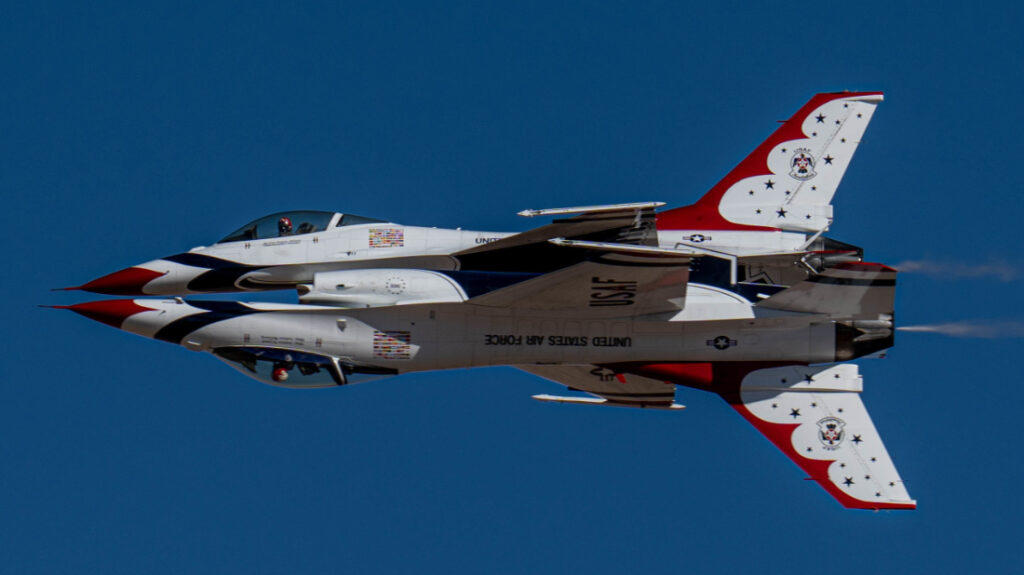
Nowadays, the Thunderbirds are one of the most-known and most-appreciated jet aerobatic teams in the world. They are also the third oldest aerobatic team in the world, flying under the same name from its establishment – after the Patrouille de France (1931) and the Blue Angels (1946).
At present, the team is led by Lt. Col. Justin ´Astro´ Elliot, commander of the 59th Test and Evaluation Squadron at Nellis AFB. Yet at the end of 2021, he was appointed the commander and formation leader for the next two years. The Thunderbirds also continue the tradition of having a female pilot in their main squad, with Maj. Lauren Schlichting as the Thunderbird 3, performing as right-wing pilot for the 2023 season.
In 2010, the USAF established a Thunderbird Museum at Nellis AFB. It became popular enough that a few years later underwent a reconstruction to meet the high standard of contemporary aviation museum and was re-opened in 2017. The exhibition is located within the air base, so usual access restrictions apply here (visitors must be a member of organized group, have a US DOD ID card or be escorted by DOD personnel). However, open public access is available during open doors events organized at Nellis AFB, such as Aviation Nation air show.
In conclusion, at the opening of the 70th air show season of the United States Air Force Air Demonstration Squadron ´Thunderbirds´, it remains to wish the group many further decades of successful aerobatic performance and setting new records in number of displays flown. The only pity is, the team visits Europe so rarely, with most performances executed only within the United States.
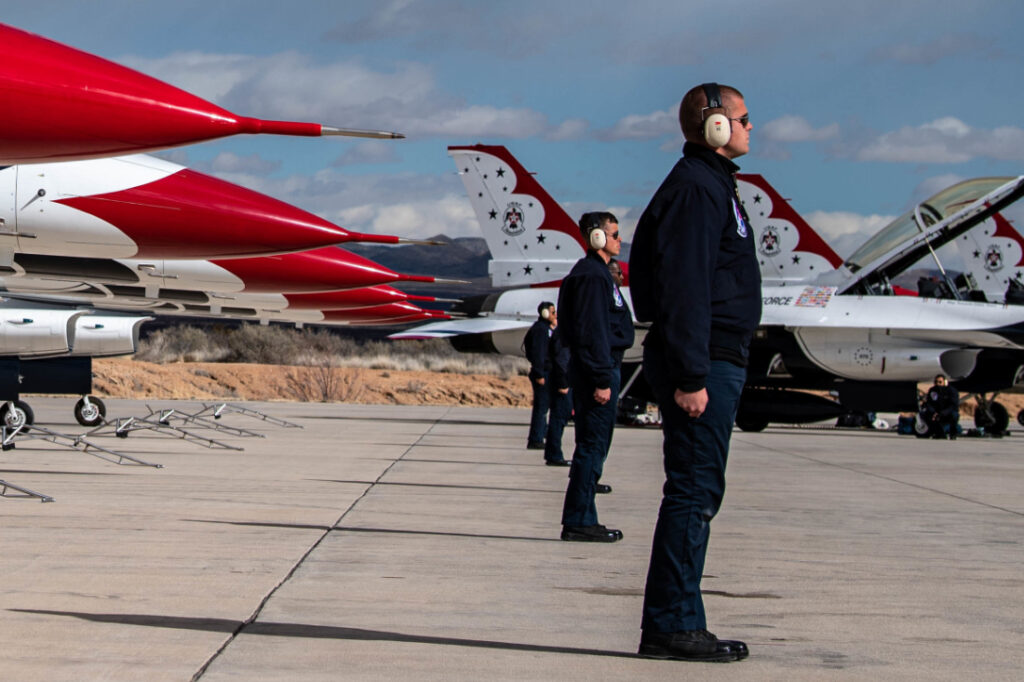
All photos used in the article, including the cover photo – The United States Air Force Air Demonstration Squadron ´Thunderbirds´ practice during the team’s inaugural winter training trip January 9 – 20, 2023 at Spaceport America, New Mexico. (USAF photo by Tech. Sgt. Nicolas Myers).
All photos © U.S. Department of Defence (DoD). DoD information materials were used, in compliance with Public Domain licence. The appearance of U.S. Department of Defense visual information does not imply or constitute DoD endorsement.

